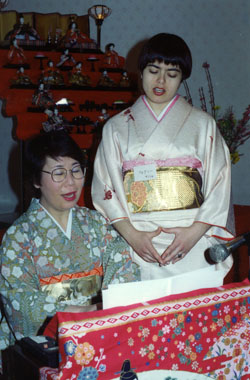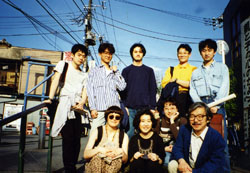Ι only spent three and a half years in Japan, in Tokyo, starting from October 1993 to April 1997, but from a distance it seems such a long and happy life!
I was accepted to the Architecture Department of the Tokyo Geijutsu Daigaku a.k.a. GeiDai, Tokyo University of the Arts (1), initially as a research and after entrance exams as a graduate student at the Urban and Environmental Design Lab of Prof. Katayama Kazutoshi (2). During my studies there I enjoyed the full support of Katayama sensei and to a great extent this contributed to eventually obtaining my Master of Fine Arts diploma (MFA) on a thesis about an urban intervention to Sanya, a run-down area North-East of Tokyo long considered an informal ghetto for homeless.
The truth is that notwithstanding my fatal attraction to anything ‘'japanese'' in my domain or the arts I was hardly prepared for the many good and the few bad that were in store for me in every-day Japan . Hard to imagine as it is, I had not even tried sushi but I was sure it couldn't be much different than Chinese food…
I also spoke and wrote embarassingly little Japanese since I had very few lessons. I was positive though that there was no place I was going to other than Tokyo , my dream city. Also I was determined to attend a non-polytechnic school, since I already had the experience of graduating from the department of Architecture of the National Technical University of Athens (Metsovio Polytehneio) in 1988.
My very first Japanese memory when I landed to Narita is olfactory: the distinct smell of soy-sauce cooking stayed with me since and never fails to lift my spirit every time I walk by Furin Kazan in Apollonos str.
I had arrived in Japan in fall, probably the best season to be there, and the first 6 months in Yokohama where along with 19 MEXT scholars from 13 countries I was going to improve my Japanese at the city university, passed in the blink of an eye.
Staying at the students' safe-heaven ‘'kaikan'' (dormitory) I had enough time to explore and get accustomed to my exquisitely intricate new ‘'home'' till I could move to my new school in Ueno and my own apartment –room actually…- in downtown Shinjuku in Tokyo . Now that I'm thinking of there were 5 more language students with whom I transferred at GeiDai and I am happy to realize that I still keep contact with 2 of them after all these years…

After Yokohama my Japanese had improved but unfortunately it was not meant to get any better even after studying for a while at a private language school. My good English combined with my Japanese acquaintances' eagerness to improve theirs left me stuck forever at Level 3 of Nihongo Nōryoku Shiken (3)…
Luckily good intentions from both sides mended any communication -or other- gaps and at times even provided for some really amusing incidents! Sure there were moments -even hours…- of tension and disappointment, especially as my staying in Japan drew to a close and pressure mounted just before my thesis presentation. Still in the end what remains is happy memories: pictures, sounds, tastes and smells, all beloved. I now recall with relish the colorful ‘'matsuri'' (festivals), the relaxing ‘'onsen'' (spas), the appreciation of Noh theatre and Bhutto dance, as well as the contemplation of ‘'chadō'' (tea ceremony) and ‘'zazen'' (Zen meditation).
I was honoured by Japanese friendships so there's always good reason to visit the country which feels like a second home. It's difficult to distinguish the part of me that got (re)activated under the influence of my Japanese experience. Definitely living in such a mega-polis like Tokyo exposed me not only to Japanese but to many different cultures turning me into a true citizen of the world. I simply wish that I helped as much in conveying some aspects of contemporary Greek culture.

(1)
On April 1, 2008, the university changed its English name from "Tokyo National University of Fine Arts and Music" to " Tokyo University of the Arts"
(2) Retired since September 2009
(3) Japanese Language Proficiency Test (JLPT) is a standardized test to evaluate and certify the Japanese language proficiency of non-native speakers. It is held twice a year in East Asia and once a year in other regions. The JLPT now has 5 levels , with Level N5 the most basic and Level N1 the most difficult. From 1984 to 2009 the test had 4 levels, with Level 4 the most basic and Level 1 the most difficult
